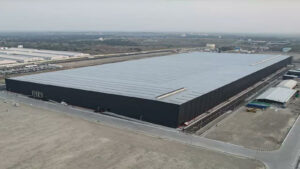Ola Electric’s gigafactory and their plans for battery cell manufacturing in India. The construction of India’s largest gigafactory in Krishnagiri, Tamil Nadu, is a significant development. Ola Electric aims to begin operations in early 2024, and the factory is expected to be spread across 115 acres.
Cell production
The gigafactory will have a phased approach to cell production, starting with a capacity of 5GWh and eventually scaling up to a maximum capacity of 100GWh. This expansion is crucial for localizing battery production, which will help reduce costs for Ola Electric. As a result, Ola’s existing electric scooters are expected to decrease, enabling the brand to offer more competitive pricing for its upcoming products.
Additionally, Ola Electric has signed a Memorandum of Understanding (MOU) with the Government of Tamil Nadu to expand further the manufacturing of two-wheelers, four-wheelers, and battery cells in India. This partnership indicates a commitment to promoting electric mobility in the country and fostering the growth of the electric vehicle ecosystem.

CEO
Moreover, Bhavish Aggarwal, the Founder and CEO of Ola, has teased the launch of a new Ola e-scooter at the Ola product event in July. It is speculated that this scooter might be a classic version of the Ola S1 Pro. Further updates are expected to be revealed at the event.
Overall, these developments showcase Ola Electric’s efforts to strengthen its presence in the electric vehicle market in India, expand battery manufacturing capabilities, and offer more affordable electric mobility solutions.
Here are some pros and cons associated with Ola Electric’s gigafactory and their plans for battery cell manufacturing:
Pros:
- Increased Localization: Establishing a gigafactory for battery cell manufacturing in India allows for more excellent localization of production. This reduces dependence on imports and helps strengthen the domestic supply chain for electric vehicles.
- Cost Reduction: Localizing battery production can significantly reduce the cost of battery packs. This, in turn, can lead to lower prices for electric vehicles, making them more affordable and accessible to a larger population.
- Competitive Pricing: By reducing the cost of battery packs, Ola Electric can price its electric scooters and upcoming products more competitively. This may help increase the adoption of electric vehicles in India and drive the overall growth of the electric mobility sector.
- Government Partnership: The Memorandum of Understanding (MOU) with the Government of Tamil Nadu demonstrates collaboration between the private sector and the government to promote electric vehicle manufacturing. Such partnerships can create a conducive environment for developing electric vehicle infrastructure and policies, further accelerating the transition to sustainable transportation.
Cons:
- Time and Operational Challenges: Constructing a gigafactory of this scale is a complex undertaking. There may be challenges in meeting the planned timeline for operations, ensuring the smooth functioning of the facility, and scaling up production to the desired capacity.
- Initial Investment: Building a gigafactory requires a significant upfront investment. Ola Electric must allocate substantial financial resources to construct and equip the facility. There may be financial risks associated with such large-scale investments.
- Market Dynamics: The electric vehicle market in India is evolving rapidly, with several players entering the space. Ola Electric will face competition from other manufacturers, both domestic and international, who are also vying for a share of the market. The success of the gigafactory will depend on Ola Electric’s ability to position itself effectively and differentiate its products in a competitive landscape.
- Environmental Impact: While electric vehicles offer reduced emissions benefits, the manufacturing process of batteries and the extraction of raw materials can have environmental implications. Ola Electric must ensure that its battery cell manufacturing processes adhere to sustainable practices and work towards minimizing its environmental footprint.
Conclusion
In conclusion, the establishment of Ola Electric’s gigafactory for battery cell manufacturing in India has both potential benefits and challenges. On the positive side, localizing battery production can lead to increased localization, cost reduction, and more competitive pricing of electric vehicles. The partnership with the government also signifies a commitment to promoting electric mobility and fostering the growth of the electric vehicle ecosystem.
However, there are potential challenges, such as the complexity of constructing and operating a gigafactory, the initial investment required, market competition, and the need to address environmental impacts associated with battery manufacturing.
Ola Electric’s gigafactory represents a significant step towards strengthening the domestic electric vehicle supply chain and driving the adoption of electric mobility in India. With proper execution and strategic positioning, it has the potential to contribute to the growth of the electric vehicle market and the transition towards sustainable transportation.































